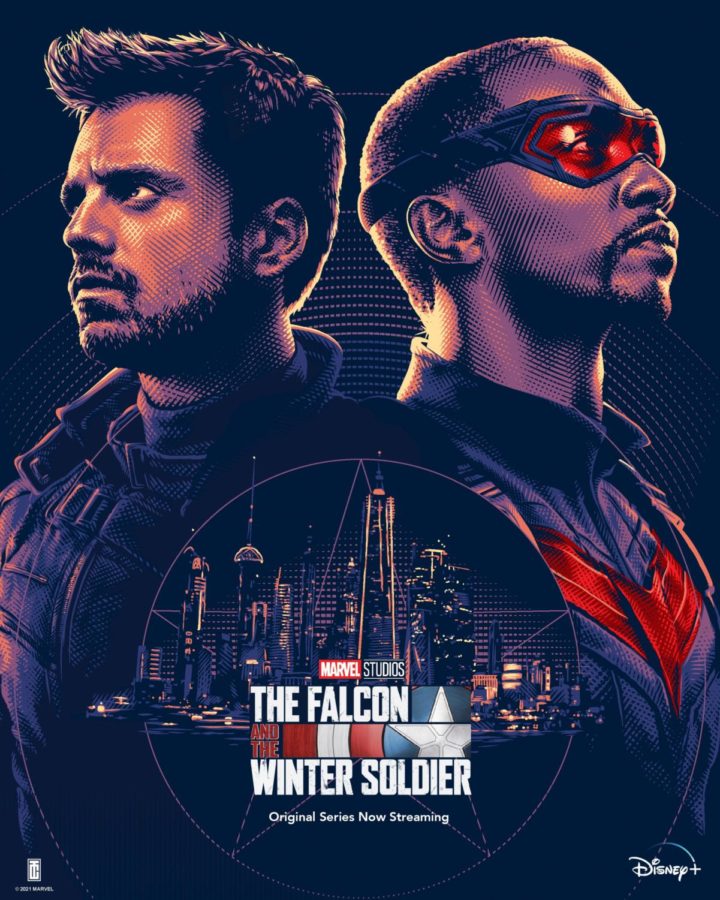The Falcon and the Winter Soldier Soars
*SPOILER ALERT FOR EPS 1-3*
The success of WandaVision set the bar high for future Marvel Disney+ shows, but their latest series, The Falcon and the Winter Soldier, does not disappoint. Since the debut of its first episode on March 19, fans have taken to the internet to discuss the return of their favorite characters and identify references to past Marvel films. While past movies depicted the title characters, also known as Sam Wilson and Bucky Barnes, as sidekicks to Captain America, the show brings these two familiar faces to the forefront. Their rivalrous dynamic remains even as they must work together to combat the latest global threat while the world is still trying to restabilize in the blip’s aftermath.
With plenty of action and snarky one-liners, the show incorporates the usual Marvel elements, but also includes a deeper look at the individual characters and the challenges they face. “These are stories featuring superhuman abilities, exploits and heroics, but they […] are also stories featuring (mostly) human beings with faults, self-doubts and vulnerabilities who are struggling to be better and do better,” says history teacher Mr. Edward Kearns.
The first episodes reacquaint viewers with Sam and Bucky, and offer a glimpse into their personal lives. As part of his pardon, Bucky is forced to address the trauma of his past by seeing a therapist, whom he is resistant to open up to. Viewers are also introduced to Sam’s family, namely his sister Sarah, who is trying to save the family business and property threatened by their mounting debt.
To avoid selling off the beloved family boat, the two attempt to procure a loan from their local bank. Their request, however, is rejected with no explanation, reflecting the history of banks arbitrarily denying loans to African American business owners. At one point Sam and Bucky seek help from Isaiah Bradley, a Black super soldier experimented on by the government but received nowhere near the recognition of Captain America. Besides this, the microaggressions and police confrontation that Sam experiences throughout the show all send the message that no one is immune to the racism that permeates our society, not even superheroes.
The plot extends far beyond the main characters’ personal conflicts, spanning continents and featuring multiple antagonistic forces, specifically the group known as the Flag Smashers. Unlike your typical supervillain, they aren’t bent on world domination, but global peace and security. After returning from the snap to find a world that has moved on without them, they manage to steal a serum that gives them the abilities of a super soldier like Captain America. They aim to redistribute resources to displaced people and connect the world under open borders, but they go about this mission by spreading violence and chaos.
“They want the world to be a better place but they just aren’t quite sure how,” says Thomas Blanchett (VI). Viewers have found it easier to sympathize with these villains, like one of their leaders, Karli Morgenthau, who has dreams of being a teacher. Her motives seem rooted in genuine care for the wellbeing of others, but the trail of death left in her wake leaves her much less redeemable.
In their hunt for the Flag Smashers, characters from past movies join The Falcon and Winter Soldier, even some from as far as Wakanda, the setting of Black Panther. But they aren’t the only ones on this crime ring’s trail. After Sam Wilson gives up Captain America’s shield, it is given without his consent to someone else. John Walker, a former soldier, becomes the new Captain America and a symbol for the nation, as well as a target of the Flag Smashers. John struggles under the expectations and pressures of his new job.
Isaac Brown (II) observes that “He’s what Captain America was never supposed to be, a good soldier but not a good man.”
Through this character, the series comments on what qualities make an outstanding leader, and just how dangerous power, which is represented by the shield, can be in the hands of someone with selfish motives. While the shield itself is a powerful symbol, so is whoever carries it. The show illustrates that putting heroes on a pedestal is never a good idea because they are just as flawed as any human.
As one character, Zemo, comments, as soon as we put people on pedestals, “we start to forget about [those] flaws.” The ending scene of the fourth episode captures this point with some shockingly graphic imagery.
It has been refreshing to see Marvel taking on relevant moral dilemmas and incorporating modern social issues into The Falcon and the Winter Soldier, and we hope to see more in the upcoming episodes.
Mr. Kearns says, “Marvel and Disney have the power to reach more people than most content creators, so it’s encouraging to see them putting forth messages of inclusion and social justice.”
He is referencing the increased effort to elevate more women and people of color within their films, and we hope that Marvel will continue on this path until everyone can see themselves represented in such an influential franchise. The Falcon and the Winter Soldier can be streamed on Disney+ and it is well worth the watch for its characters, exciting plotlines and its commentary on social issues of today.







